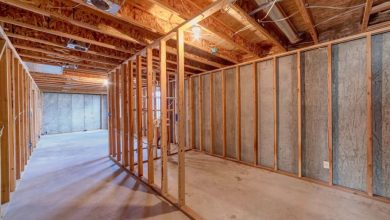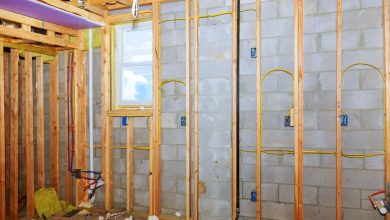How to Stop Basement Flooding with These Helpful Tips

Are you tired of dealing with basement flooding? Not only is it a major inconvenience, but it can also cause significant damage to your property. If left unchecked, basement flooding can ruin your flooring, destroy your belongings, and even lead to structural issues. However, with the right preventative measures, you can stop basement flooding in its tracks.
This article will explore some helpful tips for stopping basement flooding. These preventative measures can save you a great deal of stress, time, and money in the long run. By taking action now, you’ll be able to rest easy knowing that your basement is protected against water damage.
Whether you’re dealing with a leaky basement or are simply looking for ways to prevent future flooding, we have you covered. From sealing cracks in your foundation to installing a sump pump, we’ll protect all the essential steps for keeping your basement dry and flood-free. So, let’s dive in and learn how to stop basement flooding once and for all.
Understanding Basement Flooding
Understanding Basement Flooding is critical in preventing costly damage to your home. There are various reasons basements flood, and it is essential to know them to take preventive measures.
One common cause of basement flooding is water seeping through cracks in the foundation or poorly sealed windows and doors. Over time, these small openings can allow water to seep into the basement and cause significant water damage.
Another factor that contributes to basement flooding is heavy rainfalls or melting snow. Excess water from these sources can accumulate around the foundation and seep into the basement. This can be a problem, especially if the basement is below the water table level.
Poor drainage systems can also cause water to pool around the basement. This can happen when your gutters’ downspouts are not correctly placed, causing water to accumulate near the foundation. If your property slopes towards the house, water can pool around the basement and seep through the foundation.
Understanding the causes of basement flooding is crucial because it will help you take preventive measures. You can start by sealing the foundation, windows, and door cracks. Ensure your gutters’ downspouts are correctly placed, directing water away from the foundation. Consider installing a sump pump to remove excess water from the basement.
In summary, basement flooding can occur for several reasons, including water seeping through cracks in the foundation or poorly sealed windows and doors, heavy rainfalls or melting snow, and poor drainage systems. By understanding the causes of basement flooding, you can take preventive measures to prevent costly water damage to your home.
Check Your Home’s Drainage System
When preventing basement flooding, one of the best places to start is by checking your home’s drainage system. Ensure that the gutters and downspouts are clear of any debris. Regularly clean them to avoid blockages and ensure they effectively direct water away from your home’s foundation. Failure to do so can lead to water accumulation around your foundation, which can cause water damage or even structural issues.
Another option to consider is installing a French drain. This type of drainage system involves laying a perforated pipe in a gravel trench that channels surface water away from your home. The pipe is covered with gravel and then topped with soil, enabling water to be absorbed and directed away from your property’s foundation. This is a highly effective and long-term solution to preventing basement flooding, and it can provide you with peace of mind during heavy rainfall.
Checking and maintaining your home’s drainage system is essential in preventing basement flooding. From clearing gutters and downspouts to installing a French drain, there are several steps you can take to reduce the risk of flooding and protect your home from water damage. Being proactive means avoiding costly repairs and ensuring your home stays safe and secure, regardless of weather conditions.
Install a Sump Pump
A sump pump is essential for any homeowner who wants to prevent basement flooding. Removing water from the sump basin keeps your basement dry and protected from water damage. Installing a sump pump is a relatively easy process requiring basic hand tools and DIY knowledge.
To install a sump pump, first, find a suitable location for the pump in your basement. It would be best if you chose a spot that is close to the sump basin and has easy access to a power outlet. Once you have selected a location, drill a hole in the floor and install the sump pump according to the manufacturer’s instructions.
Before installing the pump, ensure the sump basin is clean and debris-free. This will ensure that the pump can work efficiently and effectively. You should also install a check valve on the discharge pipe to prevent water from flowing back into the basement.
To keep your sump pump working correctly, it’s important to test it regularly. Check that the pump is cycling on and off correctly and that the float switch functions correctly. You should contact a professional plumber to inspect the pump if you notice any issues, such as strange noises or reduced flow.
Basement flooding can cause significant damage to your property and is a source of stress and inconvenience for homeowners. Investing in a high-quality sump pump is an effective way to prevent basement flooding and protect your home. Following the abovementioned steps, you can install a sump pump and keep your basement dry and safe.
Seal Basement Cracks
If you’re dealing with a flooded basement, one of the most likely culprits is water seepage through the cracks in your foundation walls. Fortunately, this problem can be addressed by sealing the cracks with either hydraulic cement or epoxy. These materials are specially formulated to fill gaps and prevent water from seeping through.
To ensure that your basement is fully protected from water seepage, it’s also essential to apply waterproof coatings to your walls and floors. This will provide an additional layer of defense against moisture intrusion. When choosing a waterproofing product, look for one that is specifically designed for use in basements. These products are typically more durable and practical than generic waterproofing solutions.
Working carefully and thoroughly when sealing basement cracks or applying waterproof coatings is essential. Ensure all cracks and gaps are filled, and pay close attention to areas particularly vulnerable to water intrusion. It may also be helpful to consult a professional contractor who can offer expert advice and guidance on the best ways to protect your basement from flooding.
Taking proactive steps to seal basement cracks and applying waterproof coatings can prevent water from seeping into your basement and causing damage. With the right tools and techniques, creating a dry, comfortable living space you can enjoy for years is possible.
Fix Your Home’s Plumbing System
If you want to prevent basement flooding, it’s crucial to fix any leaky pipes and fixtures as soon as possible. This will help you avoid water damage and costly repairs. Start by checking your plumbing system and ensuring it works well.
One way to do this is to hire a professional plumber to inspect your home’s pipes and fixtures. They can identify any leaks or other issues that might be causing flooding. Once you’ve identified the problem, you can take steps to fix it.
Another way to prevent basement flooding is to be diligent about what you dispose of down the drain. Grease and oil, for example, can clog pipes and cause backups that can lead to flooding. To prevent this from happening, dispose of grease and oil properly. Instead of pouring them down the drain, you can collect them in a container and throw them away in the trash.
Some other things you can do to prevent basement flooding include cleaning your gutters and downspouts regularly, installing a sump pump, and ensuring that your home’s foundation is in good condition. By taking these simple steps, you can protect your home from water damage and keep your basement dry and healthy for years. So don’t wait – start fixing your home’s plumbing system today and say goodbye to basement flooding for good!
Consider Elevating Your Home
Basement flooding can be a significant inconvenience and cause extensive damage. If your home is in a flood-prone area, preventing water from entering your basement is essential. One effective solution is to consider elevating your home. Upgrading your home might seem expensive, but worth it in the long run.
Elevating your home means lifting it above the flood level. This can be done by raising the foundation or building a new one higher than the current one. Elevating your home can prevent water from entering your basement during floods and heavy rains.
There are several benefits to elevating your home. Firstly, it’ll protect your home from flood damage. Floodwater can cause extensive damage to your home, including the foundation, walls, and electrical systems. Elevating your home will minimize the damages and save you money in the long run. Secondly, it’ll increase the value of your home. Elevated homes are in high demand, and they offer added protection against flooding, which is appealing to potential buyers.
Elevating your home is a complex process that requires the assistance of experienced professionals. They’ll assess your home’s structure and determine the best way to upgrade it. Depending on your home’s location and the extent of the flooding risks, they recommend a partial or complete elevation.
If you live in a flood-prone area, elevating your home effectively prevents basement flooding. It might be expensive, but it’ll save you money in the long run by protecting your home and increasing its value. Contact a reputable contractor to discuss your options and get your home elevated today.
Install Window Wells and Covers
If you’re worried about water seeping into your basement, one of the leading causes is poorly sealed windows and doors. To prevent this, it’s important to install window wells and covers. Doing so ensures that water doesn’t enter your home and potentially cause significant damage.
When installing window wells and covers, it’s essential to ensure they’re made of durable materials. This will help to prevent any damage from occurring and ensure that they last longer. Additionally, you should ensure the covers fit perfectly over the window wells. This will help to prevent water from seeping through any gaps or openings.
Following the manufacturer’s instructions carefully ensures you install your window wells and covers correctly. This will help to ensure that you’re doing everything correctly and that your window wells and covers are working as intended.
Installing window wells and covers is a critical step in preventing basement flooding. Doing it right can help ensure that your home is protected from water damage and that you don’t have to deal with costly repairs.
Inspect Your Basement Regularly
Inspecting your basement regularly is essential to prevent basement flooding and water damage. Regular inspections can help identify potential water damage early on, preventing it from escalating and causing severe problems.
When inspecting your basement for water damage, look for signs such as mold, mildew, and musty odors. These are all indications that water may be present and causing damage. It is crucial to fix any damages immediately to prevent them from becoming more significant.
To ensure that your basement is inspected correctly, create a checklist of items to check, such as the walls, ceilings, floors, and any exposed pipes. Inspect these areas thoroughly for any signs of water damage or leaks.
Additionally, it is crucial to check the exterior of your home to ensure that water is properly draining away from your foundation. Ensure that gutters and downspouts are clear of debris and that water is directed away from your house.
Regularly inspecting your basement and taking necessary preventative measures can stop flooding and water damage before it becomes a severe issue. Don’t wait until it’s too late – take action to protect your home and family.
How to Stop Basement Flooding: Preventive Measures
Basement flooding can cause immense stress and damage to your home. But with proper preventive measures, you can safeguard your home against water damage. To stop basement flooding, you need to follow these essential tips:
- Check your home’s drainage system: Ensure your home’s gutters and downspouts are debris-free and functioning correctly. Make sure that they direct water away from your home.
- Install a sump pump: A sump pump is an excellent investment to protect your basement against flooding. It pumps out excess water and directs it away from your home’s foundation.
- Seal basement cracks: Seal any gaps in your basement walls and floors with epoxy, polyurethane, or other sealants to prevent water from seeping.
- Fix your home’s plumbing system: Inspect your plumbing system regularly and fix any leaks or clogs promptly to prevent water damage.
- Consider elevating your home: If it is in a flood-prone area, consider raising it higher to prevent water from entering your basement.
- Install window wells and covers: Properly installed windows can help prevent water from entering your basement through windows.
- Inspect your basement regularly: Check your basement regularly for signs of water damage, such as wet spots, mold, and musty odors.
- Fix any damages immediately: If you notice any water damage in your basement, immediately fix it before it worsens.
Final Thoughts
Basement flooding is a common concern for homeowners, and it can be a real headache when it does occur. Fortunately, there are a few preventive measures that you can take to stop flooding and enjoy a dry, welcoming basement. One of the most important things to do is to stay vigilant and take quick action at the first sign of water damage to prevent further issues.
One way to prevent basement flooding is to ensure your home’s gutters and downspouts function correctly. This means keeping them clean and debris-free and making sure they direct water away from your home’s foundation. It’s also good to check your home’s foundation for cracks and other damage, as these can allow water to seep into your basement.
In addition to these preventive measures, knowing what to do during a basement flood is essential. If you experience flooding, turn off any electrical sources before entering the basement, and wear protective clothing to avoid exposure to hazardous materials. By following these steps and staying proactive about preventing basement flooding, you can protect your home and family from the stress and damage that water damage can cause.




